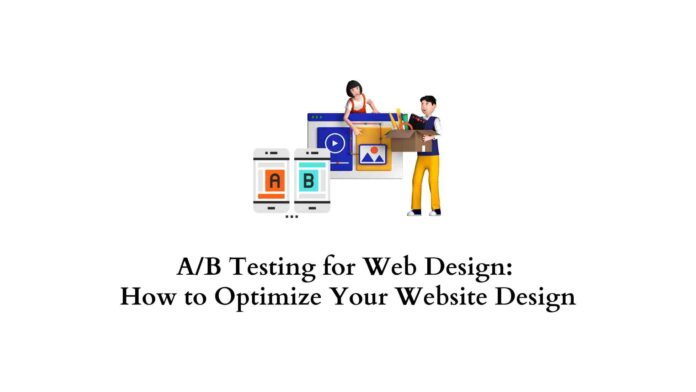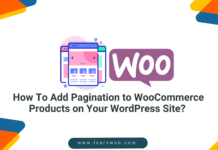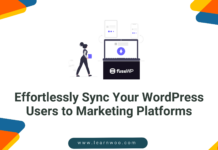Last updated - November 29, 2023
In the ever-evolving digital landscape, having an appealing and user-friendly website is crucial for success. Your website’s design can significantly impact user engagement, conversion rates, and overall business performance. But how do you know if your current design is truly effective, and how can you make data-driven improvements? This is where A/B testing for web design comes into play.
In this comprehensive guide, we will explore the concept of A/B testing, provide you with actionable insights on how to optimize your website design for better results and delve into advanced strategies to take your web design optimization to the next level.
The Power of A/B Testing
What is A/B Testing?
A/B testing, also known as split testing, is a systematic method used by web design teams and digital marketers to compare two or more versions of a web page or element to determine which one performs better in achieving a specific goal.
The process involves randomly dividing your website’s traffic into different groups and showing each group a different version of a web page or element. By measuring user interactions and conversion rates, you can identify which version is more effective in achieving your desired outcomes.
Why A/B Testing Matters for Web Design
- Data-Driven Decision Making: A/B testing allows you to base your design decisions on real data rather than assumptions or personal preferences. This data-driven approach ensures that you make changes that positively impact your website’s performance.
- Continuous Improvement: Your website is not a static entity. It should evolve to meet changing user needs and preferences. A/B testing enables you to continuously refine and enhance your design over time.
- Better User Experience: A well-designed website enhances the user experience, leading to higher engagement and lower bounce rates. A/B testing helps you pinpoint design elements that resonate most with your audience.
- Improved SEO: A website with a better user experience is likely to rank higher in search engine results, which can lead to increased organic traffic.
The Psychology of A/B Testing

To truly understand the power of A/B testing, it’s essential to delve into the psychology behind it. Human behavior on the web is influenced by various psychological factors:
- Cognitive Load: Users have limited cognitive resources, so simplifying your design can reduce cognitive load and lead to more conversions.
- FOMO (Fear of Missing Out): Creating a sense of urgency or scarcity through design elements like countdown timers can encourage users to take action.
- Visual Hierarchy: Properly structuring your web pages with clear headings and visuals can guide users through their journey and highlight important information.
- Social Proof: Testimonials, reviews, and social media sharing buttons can enhance trust and credibility, affecting user decisions.
- Emotional Triggers: The use of colors, imagery, and messaging can evoke emotions that influence user behavior.
Getting Started with A/B Testing
Steps to A/B Test Your Website Design
- Define Clear Objectives: Start by identifying specific goals for your A/B test. Do you want to increase click-through rates, boost conversions, or reduce bounce rates? Clearly define what success looks like.
- Choose What to Test: Select the design element you want to optimize. It could be your homepage, product pages, call-to-action buttons, or even minor elements like color schemes or fonts.
- Create Variations: Develop two or more versions of the chosen design element. One version should serve as the control (the existing design), while the others are the variations (with proposed changes).
- Randomly Assign Visitors: Use A/B testing tools like Google Optimize or Optimizely to divide your website traffic randomly into groups. Group A sees the control, while Group B sees the variation(s).
- Gather Data: Allow the test to run for a sufficient duration to collect meaningful data. Monitor user interactions, such as click-through rates, conversion rates, and engagement metrics.
- Analyze Results: After collecting data, analyze the performance of the control and variation(s). Pay attention to statistically significant differences in user behavior.
- Implement Changes: If the variation(s) outperform the control, consider implementing the changes permanently on your website.
- Repeat the Process: A/B testing is an ongoing process. Continuously test and optimize different elements of your website to ensure it remains effective.
Advanced A/B Testing Strategies
Multivariate Testing
While traditional A/B testing focuses on comparing two versions of a single element, multivariate testing takes it up a notch by examining multiple variables simultaneously. This approach allows you to explore how different combinations of changes impact user behavior. Multivariate testing is particularly useful when you have a complex website with multiple interacting elements.
Personalization and Dynamic Content
Tailoring your website’s content and design to individual user preferences is the holy grail of web optimization. By leveraging data analytics and user segmentation, you can create personalized experiences for your visitors. A/B testing can help you fine-tune these personalized experiences by comparing different content recommendations, layouts, and messages for various user segments.
Split URL Testing
In addition to testing individual page elements, you can also perform split URL testing to compare entirely different versions of a webpage. This is particularly useful when considering a major redesign or when you want to test different site structures. Split URL testing provides insights into which overall website design is more effective in achieving your objectives.
Best Practices for A/B Testing in Web Design

- Test One Variable at a Time: To isolate the impact of specific design changes, test one variable at a time. This ensures that you can accurately attribute any improvements or setbacks to that particular change.
- Ensure Adequate Sample Size: To obtain reliable results, ensure that your A/B test has a sufficient sample size. Small sample sizes can lead to inconclusive or inaccurate findings.
- Be Patient: Allow your A/B tests to run for a reasonable duration, as short tests may not capture user behavior accurately. Factors such as seasonality and traffic fluctuations can influence results.
- Consider Mobile Users: Don’t forget to A/B test for mobile users, as their browsing behavior may differ from desktop users. Responsive design is crucial for a seamless mobile experience.
- Document Your Findings: Keep a record of your A/B testing experiments, results, and the changes you’ve implemented. This documentation will serve as a valuable resource for future optimization efforts.
The Evolution of Web Design Optimization
As technology advances and user expectations change, web design optimization continues to evolve. Stay ahead of the curve by exploring emerging trends such as
- Voice User Interfaces (VUI): With the rise of smart speakers and voice assistants, optimizing your website for voice search and interaction is becoming increasingly important.
- Artificial Intelligence (AI): AI-driven design optimization tools can analyze user behavior in real-time and make instant design adjustments to improve engagement.
- Accessibility: Ensuring that your website is accessible to all users, including those with disabilities, is not only a legal requirement but also a fundamental aspect of design optimization.
Looking at A/B Testing in Real-Life Examples
Optimizing your website is an ongoing journey, and sometimes, inspiration can come from studying the successes of others. In this chapter, we will explore several inspiring examples of website optimization to spark your creativity and give you fresh ideas for your own A/B testing and design enhancements.
Amazon – Personalization at Scale
Amazon, the e-commerce giant, is a prime example of effective personalization. By analyzing user behavior and purchase history, Amazon provides personalized product recommendations, dynamic pricing, and tailored content. Their A/B testing efforts focus on refining these personalized features to increase conversions and customer loyalty.
Takeaway: Consider how you can use personalization to enhance the user experience on your website. A/B test personalized content, product recommendations, or even dynamic pricing strategies.
Airbnb – Trust and Credibility
Airbnb prioritizes trust and credibility by incorporating user-generated content such as reviews, ratings, and host profiles. Through A/B testing, they fine-tuned the placement and visibility of these elements to increase user confidence and booking rates.
Takeaway: Leverage user-generated content and social proof elements in your design. Test variations in how you display reviews, ratings, and trust indicators to build credibility.
Spotify – Content Discovery
Spotify excels in content discovery through its personalized playlists and recommendation algorithms. A/B testing plays a vital role in optimizing the user interface, ensuring that users easily discover new music and engage with the platform longer.
Takeaway: Explore content discovery features on your website. Test different methods of content presentation, such as personalized recommendations, curated lists, or search algorithms.
Slack – User Onboarding
Slack, a collaboration platform, invests heavily in user onboarding optimization. Through A/B testing, they refine their onboarding process, ensuring that new users quickly understand the platform’s value and become active users.
Takeaway: Focus on optimizing your user onboarding experience. Experiment with onboarding flows, tooltips, and guided tours to help users get the most out of your platform.
HubSpot – Conversion-Driven Design
HubSpot, a marketing and sales software provider, places a strong emphasis on conversion-driven design. They consistently test and refine their landing pages, CTAs, and forms to maximize lead generation and conversion rates.
Takeaway: Prioritize conversion rate optimization (CRO) in your web design. A/B test various elements like CTAs, forms, and page layouts to identify what resonates best with your audience.
Apple – Minimalistic Design
Apple is renowned for its minimalistic and user-friendly design approach. Their A/B testing efforts often revolve around simplifying product pages and checkout processes to enhance the user experience.
Takeaway: Embrace minimalistic design principles that prioritize simplicity and clarity. Test different design elements to find the right balance between aesthetics and functionality.
Netflix – Content Preview
Netflix utilizes A/B testing extensively to optimize its content preview feature. By fine-tuning how content is previewed, they aim to capture users’ interest and keep them engaged.
Takeaway: If you have content-heavy offerings, consider A/B testing different content preview methods, such as video snippets, tooltips, or interactive previews.
Dropbox – Feature Adoption
Dropbox focuses on feature adoption through A/B testing. They experiment with feature placements, tooltips, and guided tours to ensure users make the most of their file-sharing and storage platform.
Takeaway: If you have a feature-rich product, invest in A/B testing to drive feature adoption. Test different ways to introduce and educate users about key features.
Adobe – Pricing Strategy
Adobe optimizes its pricing strategy through A/B testing. By testing various pricing models, plans, and discounts, they aim to find the sweet spot that maximizes revenue while satisfying customer needs.
Takeaway: If your business involves subscription or pricing tiers, regularly A/B test your pricing strategy. Experiment with different pricing structures and discounts to find what resonates with your audience.
Incorporating elements from these inspiring examples into your own web design and A/B testing strategies can help you create a user-centric, conversion-optimized, and highly effective website.
Remember that website optimization is a dynamic process, and continuous testing and refinement are key to staying competitive in the ever-changing digital landscape.
Practical Ways to Optimize Your Website

Optimizing your website for better user engagement, conversions, and overall performance involves a combination of strategic planning and hands-on implementation. In this chapter, we’ll delve into practical steps and tips that you can apply to your website optimization efforts.
Streamline Website Navigation
A well-organized and intuitive navigation menu is essential for helping users find what they’re looking for quickly. Ensure that your menu is logically structured, with clear labels, and consider implementing dropdown menus for easy access to subpages.
Tip: Use heatmap tools to identify where users tend to click the most and optimize your menu based on these insights.
Mobile Optimization
With a significant portion of web traffic coming from mobile devices, responsive design is non-negotiable. Ensure that your website is fully optimized for mobile users, with easy-to-tap buttons, legible text, and fast loading times on all device types.
Tip: Run mobile-specific A/B tests to identify and address any issues that may be affecting mobile user experience.
Page Speed Optimization
Slow-loading pages can result in high bounce rates and lost conversions. Optimize your website’s speed by compressing images, leveraging browser caching, and minimizing HTTP requests.
Tip: Use Google’s PageSpeed Insights tool to identify specific speed-related issues on your website and follow its recommendations.
Content Quality and Relevance
High-quality, relevant content not only engages users but also boosts SEO. Regularly update your content, ensure it’s error-free, and address the needs and interests of your target audience.
Tip: Perform content audits to identify outdated or underperforming content that needs improvement or removal.
Optimize Images and Multimedia
Images and multimedia elements enhance user engagement but can also slow down your website. Compress images without compromising quality and use lazy loading for multimedia content.
Tip: Test different image formats (e.g., JPEG vs. WebP) to find the right balance between image quality and loading speed.
Clear Call-to-Actions (CTAs)
CTAs guide users toward desired actions, whether it’s signing up, making a purchase, or contacting you. Ensure that your CTAs are clear, prominently placed, and use persuasive language.
Tip: A/B test the different CTA designs, colors, and wording to determine which variations drive the most conversions.
User-Friendly Forms
If your website includes forms for lead generation or other purposes, keep them concise and user-friendly. Minimize the number of required fields and provide helpful error messages.
Tip: Experiment with multi-step forms or auto-filling to make the form-filling process smoother.
Social Proof and Trust Signals
Incorporate social proof elements like customer reviews, testimonials, trust badges, and security certificates to build trust with your audience.
Tip: A/B test the placement and presentation of trust signals to find the most effective format for your audience.
A/B Testing
Continuously run A/B tests to optimize various aspects of your website, from headlines and images to layouts and checkout processes. Use A/B testing tools to measure the impact of changes accurately.
Tip: Prioritize A/B tests based on their potential impact on your key performance indicators (KPIs).
Analytics and Data Analysis
Regularly analyze website analytics data to gain insights into user behavior. Identify pages with high bounce rates or low conversion rates and focus optimization efforts there.
Tip: Set up conversion tracking to measure the effectiveness of your CTAs and forms accurately.
SEO Best Practices
Implement on-page and off-page SEO strategies to improve your website’s visibility in search engine results. Optimize meta titles and descriptions, use relevant keywords, and build high-quality backlinks.
Tip: Perform keyword research to identify long-tail keywords and questions your audience is searching for, then create content to address these queries.
Security and Privacy
Assure users that their data is safe by implementing robust security measures and clearly communicating your privacy policy. Users are more likely to engage with a secure website.
Tip: Regularly update your website’s security features and encrypt sensitive data to protect user information.
By implementing these practical strategies, you’ll be well on your way to optimizing your website for improved user experience, increased conversions, and better overall performance.
Remember that optimization is an ongoing process, and staying informed about the latest web design and digital marketing trends is crucial to maintaining a competitive edge in the digital landscape.
Start A/B Testing on Your Website
A/B testing for web design is a powerful tool for optimizing your website’s performance and user experience. By leveraging data-driven insights and exploring advanced strategies, you can make informed design decisions that lead to higher engagement, better conversion rates, and ultimately, increased success for your online presence.
Remember that web design is an ongoing process, and A/B testing should be a continuous part of your strategy to adapt to changing user preferences and market trends. Start testing today and unlock the full potential of your website’s success.











